
Concept explainers
Give IUPAC names for the following substances (red = O, blue = N):
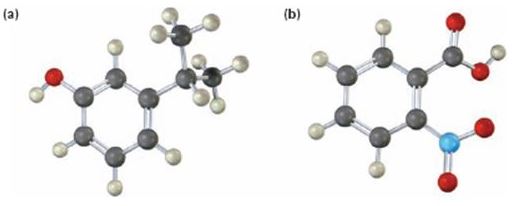
a)
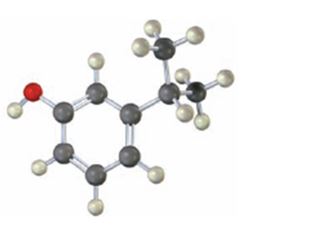
Interpretation:
The IUPAC name of the compound shown is to be given.
Concept introduction:
Compounds with a hydroxyl group attached to the benzene ring are named as derivatives of phenol. Substituted phenols are named using the prefixes ortho (o), meta (m) and para (p). An ortho-substituted phenol has an another substituent in a 1,2-relationship on the ring. A meta-disubstituted phenol has an another substituent in a 1,3-relationship on the ring. A para-disubstituted phenol has another substituent in a 1,4-relationship on the ring.
To give:
The IUPAC name of the compound shown.
Answer to Problem 13VC
The IUPAC name of the compound is m-isopropylphenol.
Explanation of Solution
The compound shown is
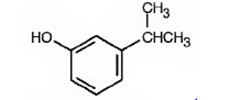
It has a hydroxyl and an isopropyl groups in the benzene ring in 1,3-relationship. Therefore its IUPAC name is m-isopropylphenol.
The IUPAC name of the compound is m-isopropylphenol.
b)
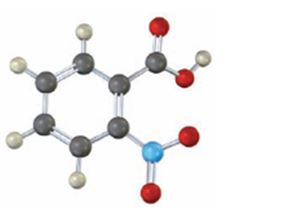
Interpretation:
The IUPAC name of the compound shown is to be given.
Concept introduction:
Compounds with a carboxyl group attached to the benzene ring are named as derivatives of benzoic acid. Substituted benzoic acids are named using the prefixes ortho (o), meta (m) and para (p). An ortho-substituted benzoic acid has an another substituent in a 1,2-relationship on the ring. A meta-disubstituted benzoic acid has an another substituent in a 1,3-relationship on the ring. A para-disubstituted benzoic acid has another substituent in a 1,4-relationship on the ring.
To give:
The IUPAC name of the compound shown.
Answer to Problem 13VC
The IUPAC name of the compound is o-nitrobenzoic acid.
Explanation of Solution
The compound shown is
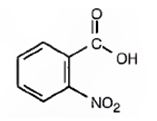
It has a carboxyl group and a nitro group in the benzene ring in 1,2-relationship. Therefore its IUPAC name is o-nitrobenzoic acid.
The IUPAC name of the compound is o-nitrobenzoic acid.
Want to see more full solutions like this?
Chapter 15 Solutions
ORGANIC CHEMISTRY W/OWL
- Denote the dipole for the indicated bonds in the following molecules. ✓ H3C CH3 B F-CCl3 Br-Cl H3C —Si(CH3)3 CH3 OH HO HO H HO OH vitamin Carrow_forward(a) What is the hybridization of the carbon in the methyl cation (CH3*) and in the methyl anion (CH3)? (b) What is the approximate H-C-H bond angle in the methyl cation and in the methyl anion?arrow_forward10:16 ☑ Vo)) Vo) 4G LTE 76% Complete the following reaction by identifying the principle organic product of the reaction. HO OH ↑ CH2N2 OH ? ○ A. 01 N₂H2C OH ОН B. HO OCH3 OH ○ C. HO OH ŎCH₂N2 ○ D. H3CO OH он Quiz navigation 1 2 3 4 5 11 12 Next page 10 6 7 8 9 10arrow_forward
- Which one of the following statements explain why protecting groups are referred to as “a necessary evil in organic synthesis”? Question 12Select one or more: A. They increase the length and cost of the synthesis B. Every synthesis employs protecting groups C. Protecting group have no role to play in a synthesis D. They minimize the formation of side productsarrow_forwardWhich of the following attributes is a key advantage of the chiral auxiliary approach over the chiral pool approach in asymmetric synthesis? Question 10Select one: A. Chiral auxiliaries are cheaper than chiral pool substrates B. Chiral auxiliary can be recovered and recycled unlike chiral pool substrates. C. The use of chiral auxiliaries provide enantiopure products, while chiral pool reactions are only enantioselective D. The chiral auxiliaries are naturally occurring and do not require synthesisarrow_forwardIn the following molecule, indicate the hybridization and shape of the indicated atoms. CH3 CH3 H3C HO: CI:arrow_forward
- Which of the following are TRUE about linear syntheses? Question 7Select one: A. They are easier to execute B. They are the most efficient strategy for all syntheses C. They are generally shorter than convergent syntheses D. They are less versatile compared to convergent synthesesarrow_forwardWhich of the following characteristics is common among chiral pool substrates? Question 4Select one: A. They have good leaving groups B. They are all achiral C. All have a multiplicity of chiral centres D. They have poor leaving groupsarrow_forwardDetermine whether the following reaction is an example of a nucleophilic substitution reaction: H NO2 H+ NO 2 + Molecule A Molecule B Is this a nucleophilic substitution reaction? If this is a nucleophilic substitution reaction, answer the remaining questions in this table. What word or two-word phrase is used to describe the role Molecule A plays in this reaction? What word or two-word phrase is used to describe the role Molecule B plays in this reaction? Use a 6 + symbol to label the electrophilic carbon that is attacked during the substitution. Highlight the leaving group on the appropriate reactant. O Yes ○ No ☐ 0 dx 000 HE ?arrow_forward
- Draw the major organic product of the Bronsted acid-base reaction. Include all lone pairs and charges as appropriate. Ignore any counterions. :0: NaOH Harrow_forward5. Calculate the total amount of heat transferred as 50 g of wat Specific heat H₂O (g) 2.00 J/g°C -10 °C. Specific heat H₂O (1) Specific heat H₂O (s) 4.18 J/g°C 2.11 J/g°C Heat of vaporization 2260 J/g Heat of fusion 334 J/g Melting point 0°C 6. Calculate the total amount of heat transferred as 25 g of water is heated from 50 °C to 100 °C as a gas. Boiling point 100 °Carrow_forwardCalculate the total amount of heat transferred as 50 g of Water -10°C. Calculate the total amount of heat transferred as 25 g of water is heated from 50°C to 100°C as a gas. \table[[Specific heat H₂O(g), 2.00°C Η 2 g 5. Calculate the total amount of heat transferred as 50 g of wat Specific heat H₂O (g) 2.00 J/g°C -10 °C. 4.18 J/g°C 2.11 J/g°C 2260 J/g 334 J/g Specific heat H₂O (1) Specific heat H₂O (s) Heat of vaporization Heat of fusion Melting point 6. Calculate the total amount of heat transferred as 25 g of water is heated from 50 °C to 100 °C as a gas. Boiling point 100 °C 0°Carrow_forward

 Introduction to General, Organic and BiochemistryChemistryISBN:9781285869759Author:Frederick A. Bettelheim, William H. Brown, Mary K. Campbell, Shawn O. Farrell, Omar TorresPublisher:Cengage Learning
Introduction to General, Organic and BiochemistryChemistryISBN:9781285869759Author:Frederick A. Bettelheim, William H. Brown, Mary K. Campbell, Shawn O. Farrell, Omar TorresPublisher:Cengage Learning Organic ChemistryChemistryISBN:9781305580350Author:William H. Brown, Brent L. Iverson, Eric Anslyn, Christopher S. FootePublisher:Cengage Learning
Organic ChemistryChemistryISBN:9781305580350Author:William H. Brown, Brent L. Iverson, Eric Anslyn, Christopher S. FootePublisher:Cengage Learning Chemistry for Today: General, Organic, and Bioche...ChemistryISBN:9781305960060Author:Spencer L. Seager, Michael R. Slabaugh, Maren S. HansenPublisher:Cengage Learning
Chemistry for Today: General, Organic, and Bioche...ChemistryISBN:9781305960060Author:Spencer L. Seager, Michael R. Slabaugh, Maren S. HansenPublisher:Cengage Learning



